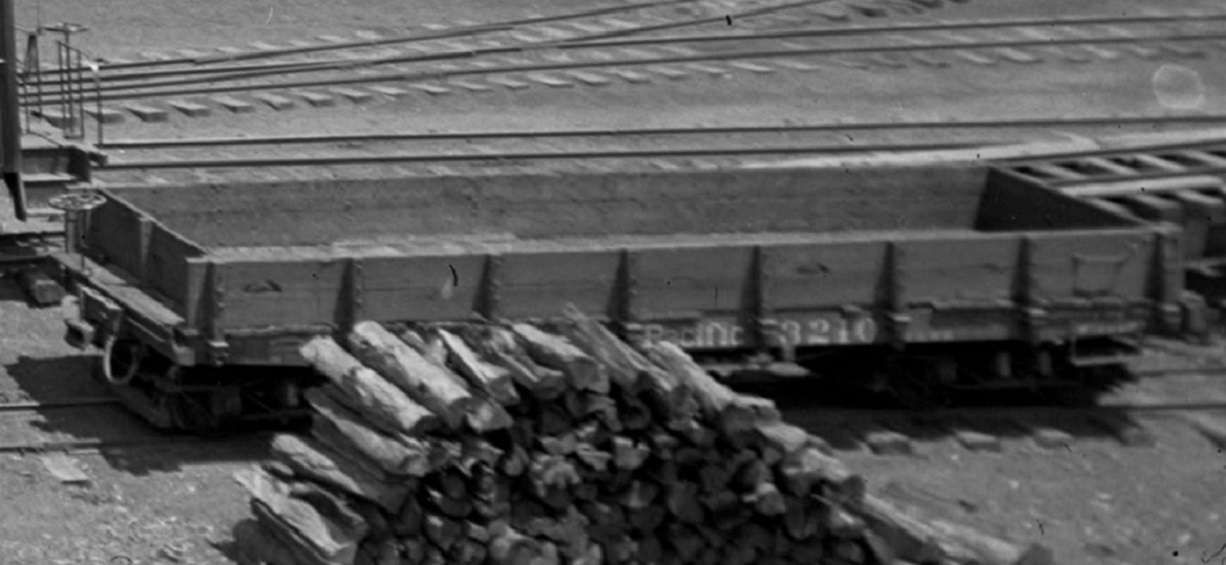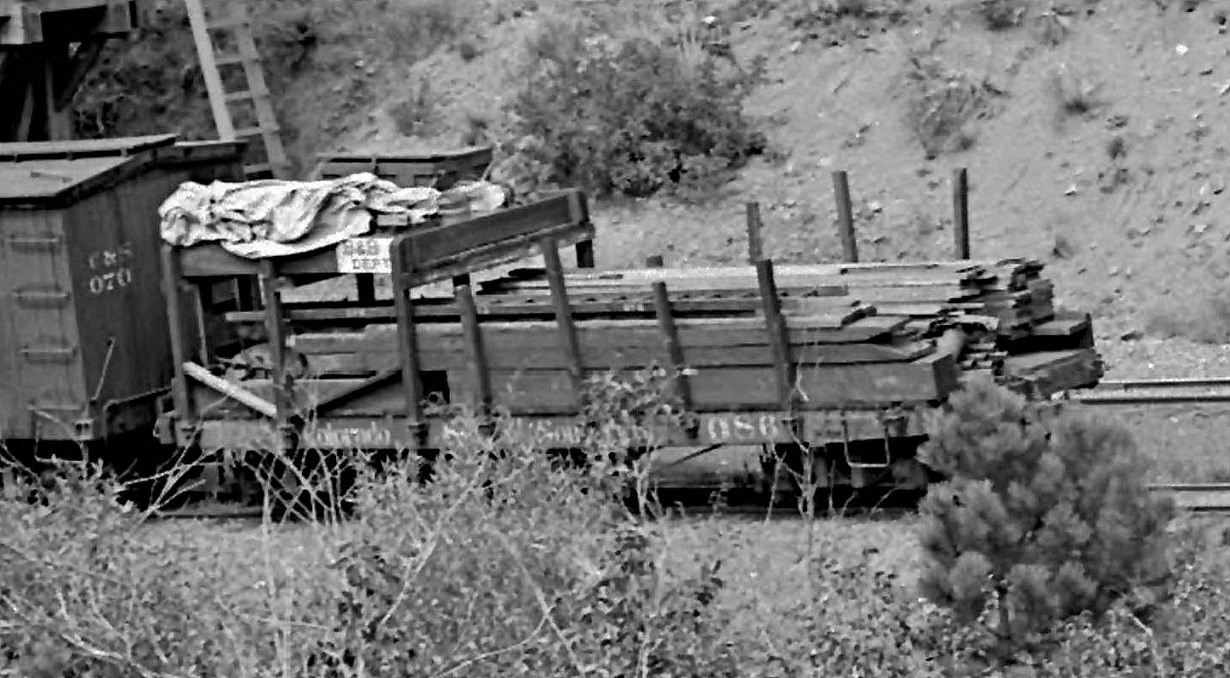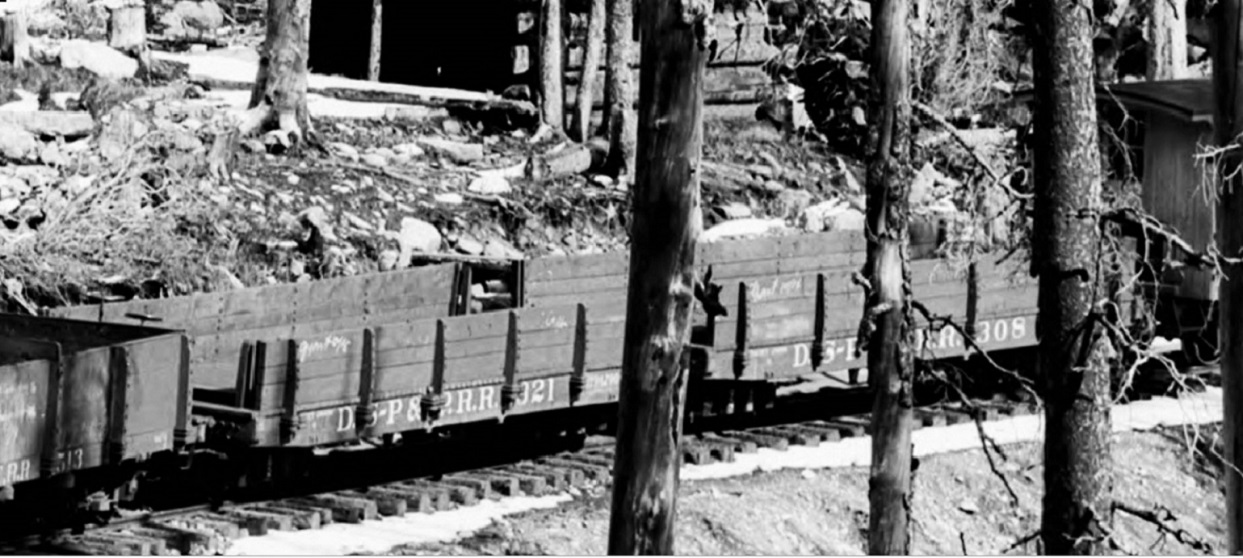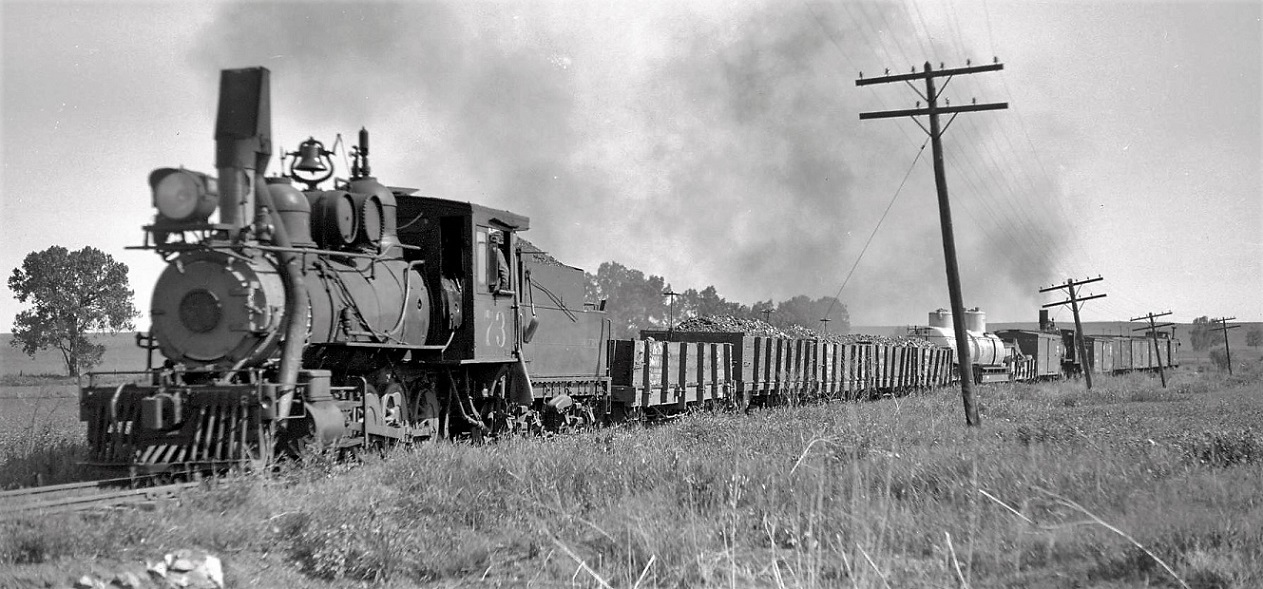Re: 1902 coal car lettering details
Posted by Jim Courtney on Oct 23, 2015; 6:27pm
URL: http://c-sng-discussion-forum.254.s1.nabble.com/1902-coal-car-lettering-details-tp3705p3735.html
Jeff,
The 4908 is indeed a 30 foot Peninsular coal car of 1884. The lettering at the smelter in Kokomo is most typical of "The Colorado Road" scheme applied to the inherited coal cars: Rectangular herald to the left, small reporting marks and number between the center stakes, name spelled out in upper/lower case Roman on the side sills. Perhaps it's best to refer to this scheme as "C&S Roman", as does Derrell in the R Rob Pictorial VIII. This photo was taken about 1901, perhaps as late as 1903, given the link-in-pin couplers on the boxcars in the same photo.
The McClure photo in the previous post, at Baileys (gentleman loading ties or lumber from his wagon) is later, likely 1909-10. The 4970, also a Peninsular 30 foot car, has been heavily shopped, with new 12 inch side sills, notched at the ends to accept the end beams. The virgin Peninsular coal cars had side sills that tapered from the bolster plate to meet the end beams, as on 4908 at Kokomo. Perhaps 4970 was shopped and lettered some time after the arrival of the ASF coal cars of 1902, but prior to 1906, and thus had the box herald relocated between the center stakes, as this was the new convention for lettering of the day.
I don't know what to think of car 4624 to the left, but it's not a 1902 ASF car nor a Peninsular 30 footer. Note that the trucks are the 14 ton UP "coal car" trucks of 1882-1883. Also, the stake pockets seem different, and the sills while tapered seem smaller. I've wavered back and forth as to whether this is a Litchfield 26 foot car that has been rebuilt with new box and stakes (Litchfield cars had 10 inch side sills, and 8, not 6, stake pockets spread out, the ones on the end very near the end beam), or one of the 27 foot UP built cars of the 300 series, built for the DSP&P in 1882, that was rebuilt with new lower sides. Consider:

This late 1890s image of one of the Litchfield coal cars looks very similar to 4624, but has 12 ton Litchfield trucks. But:

This Litchfield flat car rebuilt as a B&B work flat, c1910, has the heavier 14 ton UP "coal car" trucks like 4624 at Kokomo.
The 300 series UP built coal cars looked like this when new in 1882:

Note the tall truck transoms and taller side sills. The 400 series UP built 27 foot cars of 1883 differed in having straight side sills, and taller sides. C&S 4637 in this c1901 photo shows how they looked in the early C&S years:

All in all, I'm leaning toward 4624 as a rebuilt 26 foot Litchfield car. But who knows, perhaps it is another anomaly, another UP refugee from Utah, that was clustered into the 46xx series (for 26-27 foot coal cars) at the dawn of the C&S. If Ron Rudnick stops by to browse, I'd be interested on his opinions.
While interesting, none of this is closer to answering your question related to 1902 coal cars in 1925. I'd forget about the inherited coal cars, as the 26-27 footers seem to disappear after the 1902 coal cars arrived. And the Peninsular 30 footers, while surviving longer due to their capacity and 20 ton trucks, were likely all gone by the mid to late teens.
However, one neat car to consider for 1925 is this one:

http://digital.denverlibrary.org/cdm/singleitem/collection/p15330coll22/id/42966
I believe that the first coal car behind the engine, in this 1931 photo, is one of the surviving 3 board St Charles coal cars built in 1897 for the UPD&G, the year before the St Charles C&S cars were built (can't remember, but I think Derrell posted this point either here, or perhaps published it in one of his magazine articles).

It has re-built drop ends and has been re-numbered 4601, when rebuilt in the late 19teen's. Note the 4 mismatched extra stake pockets, typical of St Charles cars. Also note the three side boards, 12 inch on the bottom, two 10 inch boards above; and the first 2 stakes are old St Charles tapered stakes, straight up to the top of the first side board, tapering above. These cars were supposedly rebuilt in 1918, so a car modeled in the mid 1920s could wear either weathered "C&S Block" lettering or very fresh, new "C&S Button" lettering (in this case, sans "button").
And any late 1920s C&S layout might be able to squeeze in a silver CONX tank car or two, as we don't really know when they first changed from original black to interim silver. One of my RGS friends is convinced they were showing up painted silver as early as 1926 in southwest Colorado.
Just saying, they're awfully neat:

URL: http://c-sng-discussion-forum.254.s1.nabble.com/1902-coal-car-lettering-details-tp3705p3735.html
Jeff,
The 4908 is indeed a 30 foot Peninsular coal car of 1884. The lettering at the smelter in Kokomo is most typical of "The Colorado Road" scheme applied to the inherited coal cars: Rectangular herald to the left, small reporting marks and number between the center stakes, name spelled out in upper/lower case Roman on the side sills. Perhaps it's best to refer to this scheme as "C&S Roman", as does Derrell in the R Rob Pictorial VIII. This photo was taken about 1901, perhaps as late as 1903, given the link-in-pin couplers on the boxcars in the same photo.
The McClure photo in the previous post, at Baileys (gentleman loading ties or lumber from his wagon) is later, likely 1909-10. The 4970, also a Peninsular 30 foot car, has been heavily shopped, with new 12 inch side sills, notched at the ends to accept the end beams. The virgin Peninsular coal cars had side sills that tapered from the bolster plate to meet the end beams, as on 4908 at Kokomo. Perhaps 4970 was shopped and lettered some time after the arrival of the ASF coal cars of 1902, but prior to 1906, and thus had the box herald relocated between the center stakes, as this was the new convention for lettering of the day.
I don't know what to think of car 4624 to the left, but it's not a 1902 ASF car nor a Peninsular 30 footer. Note that the trucks are the 14 ton UP "coal car" trucks of 1882-1883. Also, the stake pockets seem different, and the sills while tapered seem smaller. I've wavered back and forth as to whether this is a Litchfield 26 foot car that has been rebuilt with new box and stakes (Litchfield cars had 10 inch side sills, and 8, not 6, stake pockets spread out, the ones on the end very near the end beam), or one of the 27 foot UP built cars of the 300 series, built for the DSP&P in 1882, that was rebuilt with new lower sides. Consider:

This late 1890s image of one of the Litchfield coal cars looks very similar to 4624, but has 12 ton Litchfield trucks. But:

This Litchfield flat car rebuilt as a B&B work flat, c1910, has the heavier 14 ton UP "coal car" trucks like 4624 at Kokomo.
The 300 series UP built coal cars looked like this when new in 1882:

Note the tall truck transoms and taller side sills. The 400 series UP built 27 foot cars of 1883 differed in having straight side sills, and taller sides. C&S 4637 in this c1901 photo shows how they looked in the early C&S years:

All in all, I'm leaning toward 4624 as a rebuilt 26 foot Litchfield car. But who knows, perhaps it is another anomaly, another UP refugee from Utah, that was clustered into the 46xx series (for 26-27 foot coal cars) at the dawn of the C&S. If Ron Rudnick stops by to browse, I'd be interested on his opinions.
While interesting, none of this is closer to answering your question related to 1902 coal cars in 1925. I'd forget about the inherited coal cars, as the 26-27 footers seem to disappear after the 1902 coal cars arrived. And the Peninsular 30 footers, while surviving longer due to their capacity and 20 ton trucks, were likely all gone by the mid to late teens.
However, one neat car to consider for 1925 is this one:

http://digital.denverlibrary.org/cdm/singleitem/collection/p15330coll22/id/42966
I believe that the first coal car behind the engine, in this 1931 photo, is one of the surviving 3 board St Charles coal cars built in 1897 for the UPD&G, the year before the St Charles C&S cars were built (can't remember, but I think Derrell posted this point either here, or perhaps published it in one of his magazine articles).

It has re-built drop ends and has been re-numbered 4601, when rebuilt in the late 19teen's. Note the 4 mismatched extra stake pockets, typical of St Charles cars. Also note the three side boards, 12 inch on the bottom, two 10 inch boards above; and the first 2 stakes are old St Charles tapered stakes, straight up to the top of the first side board, tapering above. These cars were supposedly rebuilt in 1918, so a car modeled in the mid 1920s could wear either weathered "C&S Block" lettering or very fresh, new "C&S Button" lettering (in this case, sans "button").
And any late 1920s C&S layout might be able to squeeze in a silver CONX tank car or two, as we don't really know when they first changed from original black to interim silver. One of my RGS friends is convinced they were showing up painted silver as early as 1926 in southwest Colorado.
Just saying, they're awfully neat:

Jim Courtney
Poulsbo, WA
Poulsbo, WA
| Free forum by Nabble | Edit this page |